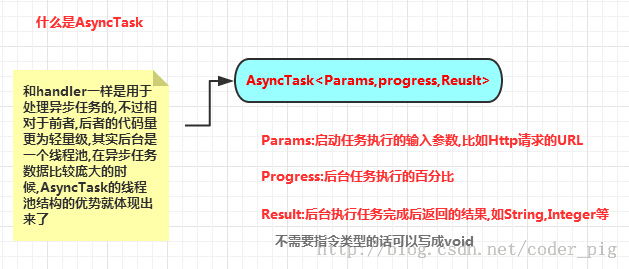android AsynTask处理返回数据和AsynTask使用get,post请求
Android是一个单线程模型,Android界面(UI)的绘制都只能在主线程中进行,如果在主线程中进行耗时的操作,就会影响UI的绘制和事件的响应。所以在android规定,不可在主线中进行耗时操作,否则将发生程序无响应(ANR)问题。
解决办法:开启新的线程进行耗时操作
开启新的线程可以new Thread() 或实现Runnable接口
什么要使用AsyncTask呢?
如果是使用Thread的run()方法,run()结束之后没有返回值。所以必须要自己建立通信机制
AsyncTask将所有的线程通信都封装成回调函数,调用逻辑容易书写。尤其是在异步处理结束之后,有回调函数进行收尾处理。咳咳,程序员都懒的么
Android给我们提供的一个轻量级的用于处理异步任务的类:AsyncTask 当然是那个简单就用那个咯
最后还有一点就是:Android 4.0后禁止在UI线程中执行网络操作~不然会报:android.os.NetworkOnMainThreadException
什么是AsyncTask(原谅宝宝偷的图 嘿嘿 不过真的解释的很清楚呢)


注意:
Task的实例必须在UI Thread中创建
execute方法不惜在UI thread中创建
task只能被执行一次 多次调用时会出现异常
通用AsyncTask 以及在主线程中使用网络请求回返的数据
通用AsyncTask是什么意思呢 发送不同的请求返回不同类型的数据 难道要一个类型写个AsyncTask 岂不是麻烦死咯
还有一种情况 我们通过异步任务得到了一个对象 然后在一下行立刻使用这个对象 逻辑完全没问题 但是运行之后会报空指针异常。这是怎么回事呢?
AsycnTask开始了一个新的线程,但是主线程并没有停止还在继续运行,马上就使用这个对象,而你新开的线程可能正在访问网络这个对象为空
你无法确定AsycnTask什么时候才能获取到数据,网快嗖的一下就好了,网慢就要等好久。
看一个简略的小例子
首先呢 我们使用异步任务的时候要处理不同类型的数据 把这个Http设置泛型类 第三个参数返回值类型 设置为泛型 不管你是什么类型的数据 全部ok
我又写了一个接口 作为Http的属性 在onPostExecute方法调用其中的onResponse方法 在Test中实现接口
这个接口的作用 完全可以理解为一个监听事件 checkbox的改变监听 触发条件是 是否选中 这个接口监听是否有数据 完成网络访问有数据的时候就调用
我们在主线程中完成接口的实现 已经在主线程中实现了 返回来的数据还不是任君宰割阿~~~~~
public class Http<T> extends AsyncTask<String,Void,T> { private OnResponseListener<T> listener; public void setListener(OnResponseListener<T> listener) { this.listener = listener; } @Override protected T doInBackground(String... params) { return null; } @Override protected void onPostExecute(T t) { super.onPostExecute(t); if (listener!=null){ listener.onResponse(t); } } //接口 类似一个监听事件 public interface OnResponseListener<T>{ void onResponse(T t); } } //获取数据的测试类 public class Test { //要获取的user对象 private User user1=null; public void get(){ //创建网络访问实例 Http<User> http=new Http<User>(); //重写接口 http.setListener(new Http.OnResponseListener<User>() { @Override public void onResponse(User user) { user1=user; } }); http.execute("xxx.balabala.com"); } }
在发送请求的时候很容易就带个参数,请求的方式呢 无非就是get,post 两者的区别呢 大白话的说 get不安全 参数通过url直接传过去 post安全 参数加密一下子
下面贴一下AsyncTask在get和post请求时核心代码 doInBackground方法
GET
protected T doInBackground(String... params) { //网络连接对象 HttpURLConnection connection=null; //输入流 获取网络数据 InputStream is=null; //字节数组输出流 ByteArrayOutputStream bos=null; try { //获取网络连接对象 connection=(HttpURLConnection) new URL(params[0]).openConnection(); //设置get请求 必须大写 connection.setRequestMethod("GET"); //获取网络请求码 200 400 500之类 不懂百度 int code=connection.getResponseCode(); if(code==200){ //获取流 is=connection.getInputStream(); //临时字节数组 byte [] b=new byte[1024]; int len=-1; bos=new ByteArrayOutputStream(); while ((len=is.read(b))!=-1){ //写入数据 bos.write(b,0,len); } String json=bos.toString("utf-8"); T t=JSON.parseObject(json,type); return t; }else{ Log.e("error","网络访问失败==========="+code); } } catch (IOException e) { e.printStackTrace(); }finally { try { if (bos!=null){ bos.close(); } if (is!=null){ is.close(); } } catch (IOException e) { e.printStackTrace(); } if (connection!=null){ connection.disconnect(); } } return null; }
POST
post和get的区别 就是post多了一段处理参数的代码
protected T doInBackground(String... params) { //分割url 分为地址和参数两部分 String[] strArr=params[0].split("\\?"); HttpURLConnection connection=null; //输出流 OutputStream os=null; //输入流 InputStream is=null; ByteArrayOutputStream bos=null; try { connection=(HttpURLConnection) new URL(strArr[0]).openConnection(); connection.setRequestMethod("POST"); //设置允许输入 输出 默认值true 不写也可以 connection.setDoOutput(true); connection.setDoInput(true); os=connection.getOutputStream(); //把参数写入 os.write(strArr[1].getBytes("utf-8")); os.close(); int code=connection.getResponseCode(); if(code==200){ is=connection.getInputStream(); byte [] b=new byte[1024]; int len=-1; bos=new ByteArrayOutputStream(); while ((len=is.read(b))!=-1){ bos.write(b,0,len); } String json=bos.toString("utf-8"); T t=JSON.parseObject(json,type); return t; }else{ Log.e("error","网络访问失败==========="+code); } } catch (IOException e) { e.printStackTrace(); }finally { try { if (bos!=null){ bos.close(); } if (is!=null){ is.close(); } } catch (IOException e) { e.printStackTrace(); } if (connection!=null){ connection.disconnect(); } } return null; }




 浙公网安备 33010602011771号
浙公网安备 33010602011771号